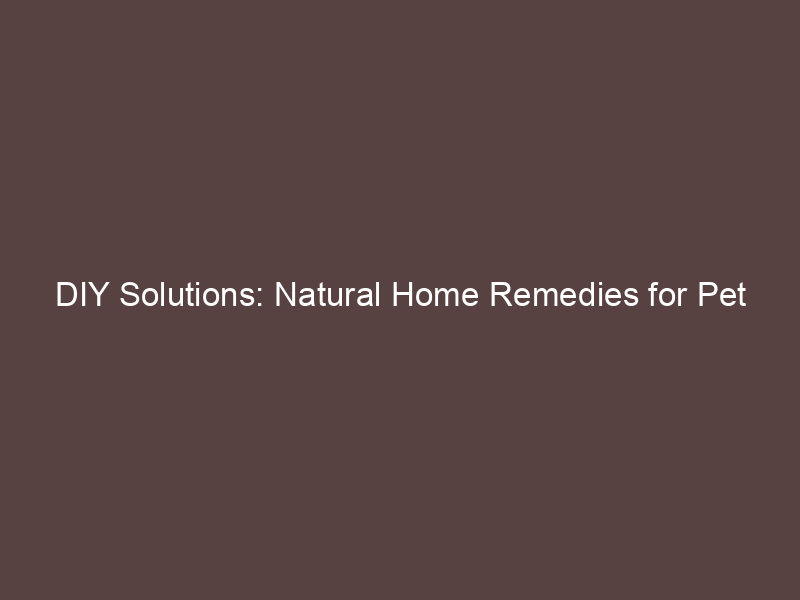Understanding Pet Allergies
When it comes to our furry friends, it’s not all fun and games. Sometimes, our bodies can react negatively to them, leading to what we call pet allergies. In this section, we will explore what pet allergies are, their common triggers, and the symptoms of dog allergies in humans.
- Definition of Pet Allergies
- Common Triggers of Pet Allergies
- Dog Allergy Symptoms in Humans
Pet allergies occur when your immune system overreacts to proteins found in a pet’s skin cells, saliva, or urine. This reaction can cause various symptoms, ranging from mild to severe. According to the American College of Allergy, Asthma, and Immunology, about 10% to 20% of the population is allergic to dogs or cats.
The most common triggers of pet allergies are proteins found in a pet’s dander (dead skin), saliva, and urine. These allergens can become airborne and stick to furniture, clothes, and other surfaces. They can also be directly transferred through a pet’s lick or bite. Some breeds of dogs and cats are more likely to cause allergies than others.
When a person with a dog allergy is exposed to a dog, they may experience various symptoms. These can include sneezing, runny or stuffy nose, red, itchy or watery eyes, and coughing. In more severe cases, a person may experience difficulty breathing, chest tightness, or even an asthma attack. It’s important to note that symptoms can appear within minutes of exposure or can take several hours to manifest.
Understanding pet allergies is the first step towards managing them effectively. In the following sections, we will delve into recognizing dog allergy rash in humans, pet dander allergy treatment, dog allergy remedies for humans, home remedies for pet allergies, and how to prevent pet allergies. Stay tuned for more insights and practical tips.
Recognizing Dog Allergy Rash on Humans
When a person is allergic to dogs, their immune system reacts to certain substances found in a dog’s skin cells, saliva, or urine. This reaction can often lead to a skin condition known as a dog allergy rash. Recognizing this rash can be the first step towards managing your pet allergies effectively. Here’s how you can identify it.
- Identifying Dog Allergy Rash
- Common Areas Affected by Dog Allergy Rash
- How to Differentiate Dog Allergy Rash from Other Skin Conditions
A dog allergy rash usually appears as red, itchy bumps on the skin. These may be accompanied by other symptoms such as sneezing, runny nose, or watery eyes. The rash can appear anywhere on the body but is most commonly found on areas where direct contact with the dog has occurred.
The most common areas affected by a dog allergy rash are the hands, arms, face, and neck. These are areas that often come into direct contact with a dog. However, a rash can appear anywhere on the body, especially if the person has been in close contact with the dog or its bedding.
It’s important to differentiate a dog allergy rash from other skin conditions. While the red, itchy bumps are a common symptom, they can also be caused by other conditions such as eczema or psoriasis. One key difference is that a dog allergy rash will often appear soon after contact with a dog. If you notice a rash appearing after spending time with a dog, it’s likely to be a dog allergy rash. However, if you’re unsure, it’s always best to seek medical advice.
Recognizing a dog allergy rash is the first step in managing your pet allergies. Once you’ve identified the rash, you can take steps to reduce your exposure to the allergens and seek appropriate treatment. Remember, it’s always best to consult a healthcare professional if you’re unsure about your symptoms.
Pet Dander Allergy Treatment
If you’re suffering from pet allergies, you’re not alone. Millions of people worldwide experience the same sneezing, itching, and discomfort that you do. But don’t worry, there are several medical treatments available that can help manage your symptoms. Let’s take a look at some of the most common ones.
Medical Treatments
Medical treatments for pet allergies aim to reduce the symptoms and improve your quality of life. Here are the top three treatments recommended by doctors:
- Antihistamines
- Decongestants
- Immunotherapy for dog allergies
Antihistamines are the most common treatment for pet allergies. They work by blocking the action of histamine, a substance in the body that causes allergic symptoms. Antihistamines can help relieve sneezing, itching, and runny nose. Some examples of over-the-counter antihistamines include Cetirizine (Zyrtec), Fexofenadine (Allegra), and Loratadine (Claritin).
Decongestants are another type of medication used to relieve nasal congestion, one of the most common symptoms of pet allergies. They work by shrinking the blood vessels in the nasal passages, making it easier to breathe. Examples of over-the-counter decongestants include Pseudoephedrine (Sudafed) and Phenylephrine (Neo-Synephrine).
Immunotherapy, also known as allergy shots, is a long-term treatment that can help reduce your body’s allergic response. It involves regular injections of a small amount of the allergen (in this case, dog dander) over several years. This treatment can be very effective, but it requires a significant time commitment and must be administered under the supervision of a healthcare professional.
Remember, it’s important to consult with your doctor before starting any new medication or treatment plan. They can help you choose the best treatment for your specific symptoms and health situation.
Natural Remedies
While medical treatments are often effective in managing pet allergies, there are also a variety of natural remedies that can provide immediate relief. These remedies can be especially beneficial for those who prefer a more holistic approach to health. Let’s explore some of these options.
- How to stop dog allergies immediately using natural remedies
- Homeopathic remedies for cat allergies in humans
- Natural remedies for pet allergies in humans
One of the most effective natural remedies for dog allergies is Quercetin, a plant pigment found in many fruits and vegetables. Quercetin acts as a natural antihistamine and anti-inflammatory. You can incorporate more Quercetin into your diet by eating more apples, berries, grapes, and broccoli. It’s also available in supplement form.
Homeopathy offers several remedies for cat allergies. One of the most popular is Histaminum, which is made from histamine dihydrochloride. It works by helping the body to build a tolerance to allergens. Another homeopathic remedy is Allium Cepa, made from red onion, which can help to relieve symptoms such as watery eyes and a runny nose.
There are several natural remedies that can help to alleviate pet allergies in general. These include saline nasal rinses, which can help to clear allergens from the nasal passages, and probiotics, which can help to balance the immune system and reduce allergic reactions. Additionally, maintaining a clean environment by regularly vacuuming and dusting can help to reduce allergen levels in the home.
In conclusion, while pet allergies can be troublesome, there are many natural remedies available that can provide immediate relief. However, it’s important to remember that everyone is different, and what works for one person may not work for another. Therefore, it’s always a good idea to consult with a healthcare professional before starting any new treatment regimen.
Dog Allergy Remedies for Humans
When you’re a dog lover, but your body doesn’t share the same affection, it can be quite a challenge. But don’t worry, there are several remedies available to help manage your dog allergies. These remedies can be categorized into three main types: over-the-counter treatments, prescription treatments, and natural remedies.
- Over-the-counter treatments
These are medications that you can buy without a doctor’s prescription. They are usually the first line of defense against dog allergies. Antihistamines, such as Benadryl and Claritin, can help reduce sneezing, itching, and runny nose. Nasal sprays like Flonase and Nasacort can also be used to relieve nasal congestion. Remember, it’s important to follow the instructions on the package for safe use.
- Prescription treatments
If over-the-counter treatments aren’t enough, your doctor may prescribe stronger medications. These could include corticosteroids to reduce inflammation and swelling, or leukotriene modifiers to block the action of certain immune system chemicals. In some cases, allergy shots (immunotherapy) may be recommended. This involves getting regular injections of a small amount of the allergens that trigger your symptoms, to help your body build up a tolerance.
- Natural remedies
For those who prefer a more natural approach, there are several options to consider. Quercetin, a natural bioflavonoid found in fruits and vegetables, can help stabilize mast cells and prevent them from releasing histamine. Probiotics, which are beneficial bacteria, can also help boost your immune system and reduce allergic reactions. Always consult with a healthcare professional before starting any new supplement regimen.
In conclusion, while dog allergies can be a nuisance, they don’t have to stand in the way of your love for your furry friend. With the right treatment plan, you can manage your symptoms and enjoy your time with your pet. Remember, it’s always best to consult with a healthcare professional to determine the most effective treatment for your specific needs.
Home Remedies for Pet Allergies
Living with pets can be a joy, but for some, it can also lead to allergies. If you’re one of those who experience sneezing, itching, or other allergic reactions around your furry friends, don’t worry. There are several home remedies you can try to alleviate your symptoms. Here are some effective strategies:
- Regular Cleaning and Vacuuming
- Using Air Purifiers
- Limiting Pet’s Access to Certain Areas
One of the simplest ways to reduce pet allergens in your home is through regular cleaning and vacuuming. Pet dander, which is a common cause of allergies, can accumulate on surfaces and in the air. By cleaning your home regularly, you can significantly reduce the amount of dander and other allergens. Vacuuming is particularly effective as it can remove allergens from carpets and upholstery where they tend to settle.
Air purifiers can also be a great help in managing pet allergies. These devices work by filtering the air in your home, removing allergens and other particles. This can result in cleaner, healthier air, which can be beneficial for those with pet allergies. Remember to change the filters regularly for the best results.
Another effective strategy is to limit your pet’s access to certain areas of your home, particularly your bedroom. By keeping these areas pet-free, you can create a ‘safe zone’ where you can retreat if your allergies flare up. This can also help reduce the amount of pet dander in these areas.
Remember, everyone’s experience with pet allergies is unique. What works for one person may not work for another. It may take some trial and error to find the best strategies for you. However, with patience and consistency, you can live comfortably with your pets without suffering from severe allergic reactions.
Preventing Pet Allergies
Preventing pet allergies is a crucial part of maintaining a healthy and comfortable home environment, especially for those who are prone to allergic reactions. There are several effective strategies that can be employed to keep allergies at bay. Let’s delve into these methods:
- Regular grooming of pets
- Keeping pets off furniture
- Using hypoallergenic pet products
Regular grooming is not just about keeping your pets looking their best, but it also plays a significant role in preventing allergies. Pet dander, which is a common allergen, can be significantly reduced by frequent grooming. Brushing your pet’s fur regularly can help remove loose hairs before they end up on your furniture or carpet. Additionally, bathing your pet every few weeks can help reduce the amount of allergens on their fur. Remember, it’s not just about frequency, but also about using the right grooming tools and techniques.
Another effective strategy to prevent pet allergies is to keep your pets off your furniture. Pets, especially dogs and cats, can leave behind dander and other allergens on your couch, chairs, and beds. These allergens can then be easily inhaled, leading to allergic reactions. By training your pets to stay off the furniture, or by covering your furniture with washable covers, you can significantly reduce your exposure to these allergens.
Lastly, using hypoallergenic pet products can also help in preventing pet allergies. These products, which include shampoos, conditioners, and even certain types of pet food, are designed to minimize the production of allergens. They can be particularly beneficial for people who are highly sensitive to pet allergens. However, it’s important to remember that not all “hypoallergenic” products are created equal, so it’s always a good idea to do some research and choose products that have been proven to be effective.
By implementing these strategies, you can enjoy the company of your beloved pets without the constant worry of triggering an allergic reaction. Remember, prevention is always better than cure, especially when it comes to pet allergies.
Case Studies: Successful Management of Pet Allergies
Let’s take a look at some real-life examples of how pet allergies can be successfully managed. These case studies will provide you with practical insights and strategies that have been proven to work.
- Case study 1: Successful use of immunotherapy for dog allergies
- Case study 2: Effective home remedies for pet allergies
- Case study 3: Managing dog allergy symptoms in humans with natural remedies
Meet John, a 35-year-old man who loves dogs but was diagnosed with severe dog allergies. His symptoms included sneezing, itchy eyes, and skin rashes. After trying various medications with little success, his doctor suggested immunotherapy. This treatment involved getting small doses of the allergen, in this case, dog dander, to help his body get used to it. After a few months of treatment, John’s symptoms significantly reduced. He can now spend time with his beloved pet without any allergic reactions. This case study shows that immunotherapy can be a successful treatment option for severe dog allergies.
Susan, a 45-year-old woman, was allergic to her pet cat. She suffered from a runny nose and watery eyes whenever she was around her pet. Not wanting to part with her feline friend, she decided to try some home remedies. She started by cleaning her house thoroughly to reduce the amount of pet dander. She also started bathing her cat regularly to reduce the allergens. Within a few weeks, Susan noticed a significant improvement in her symptoms. This case study demonstrates that simple home remedies can effectively manage pet allergies.
Tom, a 50-year-old dog lover, suffered from dog allergies. His symptoms included coughing, wheezing, and skin rashes. He was keen on finding a natural remedy for his condition. After researching, he started taking a spoonful of local honey daily. The idea was that the local honey would help his body get used to the local allergens, including dog dander. After a few months, Tom noticed a significant reduction in his allergy symptoms. This case study highlights that natural remedies can be effective in managing dog allergy symptoms in humans.
In conclusion, managing pet allergies can be achieved through various methods, including immunotherapy, home remedies, and natural remedies. It’s crucial to find a solution that works best for you and your pet.
Key Takeaways: Managing Pet Allergies
As we conclude our comprehensive guide on managing pet allergies, let’s summarize the key points we’ve discussed. These takeaways will help you understand, recognize, treat, and prevent pet allergies effectively.
- Understanding the cause of pet allergies: Pet allergies are primarily caused by proteins found in a pet’s skin cells, urine, and saliva. These proteins are known as allergens. When a person who is allergic to pets comes into contact with these allergens, their immune system overreacts, leading to allergic symptoms.
- Recognizing symptoms of pet allergies: Common symptoms of pet allergies include sneezing, runny or stuffy nose, red, itchy or teary eyes, and skin rashes. In severe cases, a person may experience difficulty in breathing. It’s important to recognize these symptoms early for effective treatment.
- Exploring various treatment options: There are several treatment options available for managing pet allergies. These include over-the-counter antihistamines, nasal sprays, and decongestants. In severe cases, immunotherapy (allergy shots) or a short course of corticosteroid medication may be recommended by a healthcare provider.
- Preventing pet allergies: While it’s not possible to completely prevent pet allergies, there are steps you can take to reduce your exposure to pet allergens. These include keeping pets out of the bedroom, using air purifiers, washing pets regularly, and cleaning your home frequently.
Remember, managing pet allergies is a journey, not a destination. It requires patience, consistency, and a willingness to make lifestyle changes. With the right knowledge and tools, you can live a healthy, happy life with your furry friends.






